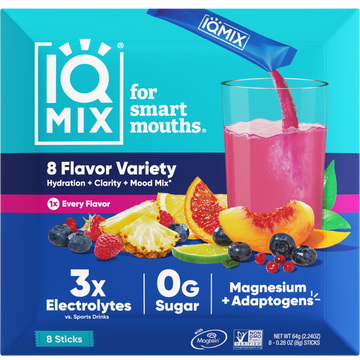When following a keto diet, fat is the name of the game.
Keto dieters eat about 60-70 percent of their calories from fat, 25-30 percent from protein, and 5-10 percent from carbohydrates. This macronutrient profile shifts the body into ketosis - a state in which fat is burned for fuel (instead of carbohydrates).
While having permission to consume more fat can feel liberating, it’s important to understand that not all fats are created equal. There are healthy fat sources and unhealthy fat sources, so it’s essential to fill your plate with the most wholesome options.
Not sure which fats to include and which to avoid? No worries—we’ve got you covered! This article will give you the low-down on healthy fats for keto and guide you in making the best choices for your health.
What Is Fat and How Does It Support the Body?
Fat is an essential macronutrient that can be found in both animal and plant foods. While its main function on a keto diet is to provide your body with energy in the absence of carbs, it plays several other vital roles, including:[*][*][*]
- Helping your body absorb fat-soluble vitamins, including vitamins A, D, E, and K.
- Regulating inflammation and immunity.
- Maintaining the health of your cells.
- Helping you feel full and satisfied.
Good Fats vs. Bad Fats
Fatty foods contain molecules called triglycerides—the most common form of fat found in the bloodstream. Once fatty foods have been digested, their triglycerides are broken down into individual fatty acids, which are burned for energy or stored for later.
There are four types of fatty acids: saturated fat, monounsaturated fat, polyunsaturated fat, and trans fat. Which of these fats deserve a place on your keto plate? Let’s find out.
#1: Saturated Fat
Saturated fat, which is found in popular keto foods like meat, butter, ghee, coconut oil, egg yolks, and full-fat dairy, is a hot topic in the nutrition world.
For several decades, the American Heart Association and other health organizations have advised people to reduce their saturated fat intake to reduce the risk of heart disease.[*] However, that recommendation is mainly based on low-quality observational studies.
Newer, more in-depth research tells a different story. Two large meta-analyses analyzing nearly one million people found no significant evidence linking saturated fat with an increased risk of cardiovascular disease.[*][*]
Many foods high in saturated fats are incredibly healthy. Take egg yolks, for instance, which are brimming with essential nutrients like choline, iron, and vitamin A. Additionally, saturated fats tend to have a high smoke point compared to other fats, making them ideal for high-heat cooking.
Bottom line: Saturated fat can be part of a healthy, balanced keto diet (or any diet for that matter).
#2: Monounsaturated Fat
There’s no controversy when it comes to monounsaturated fats, which are found in foods like olives, extra virgin olive oil, avocado, avocado oil, and various nuts. Research consistently links this type of fat to health benefits like lower blood pressure and healthier blood sugar levels.[*]
Bottom line: Monounsaturated fat is the king of healthy fats. Liberally include it in your keto diet for better health.
#3: Polyunsaturated Fat
Polyunsaturated fat (PUFA) can be split into two classes—omega-3 fats and omega-6 fats. While both types are essential fatty acids (meaning your body cannot produce them and they must be sourced from your diet), it’s important to maintain a healthy balance between the two.
Consuming excess omega-6s has been shown to produce adverse health effects like inflammation, obesity, heart disease, and diabetes.[*][*]
Increased omega-3 consumption, on the other hand, has been linked to reduced inflammation, which can benefit weight loss, autoimmune conditions, and disease prevention.[*]
The average American consumes way more omega-6 than omega-3, creating a ratio of around 20:1.[*] Ideally, aim to bring that ratio down to around 4:1.[*]
Omega-6s are found in many healthy foods, including nuts, seeds, meat, fish, and eggs, but they’re also found in some unhealthy foods, namely overly-processed vegetable oils. These include soybean oil, sunflower oil, safflower oil, cottonseed oil, and peanut oil.
Cutting out healthy foods like nuts and eggs is not the way to reduce your omega-6 intake. Instead, eliminate the overly-processed oils mentioned above. In their place, use healthier oils like avocado oil, olive oil, and coconut oil.
Simultaneously, increase your intake of foods high in omega-3s, including fatty fish, chia seeds, flaxseeds, hemp seeds, and walnuts.
Bottom line: Both omega-6s and omega-3s are necessary, but consuming the right ratio is key.
#4: Trans Fat
Trans fats naturally occur in small amounts in some animal products. These natural trans fats are not a concern, but artificial trans fats most definitely are.
Artificial trans fats (often labeled as hydrogenated or partially hydrogenated oils) are added to many processed foods to extend their shelf life. They’re commonly found in fried foods, baked goods, margarine, frozen pizza, crackers, processed meats, and fast food.
On a keto diet, you should be avoiding many of these foods anyway, but here’s some extra incentive to do so. Artificial trans fats come with an increased risk of serious health issues, including weight gain, cardiovascular disease, and type 2 diabetes.[*]
Bottom line: Everyone—not just those on a keto diet—should avoid consuming foods with added trans fats.
How to Get Enough Healthy Fat on a Keto Diet
When starting a keto diet, consuming 60-70 percent of your calories from fat can feel like a daunting task, but it’s easier (and more delicious) than you probably think.
Here are our top tips for upping your intake of healthy fat:
- Embrace eggs (unless you’re vegan!). Containing about 65 percent fat, 35 percent protein, and zero carbs, eggs fit perfectly into keto macros. They’re also nutrient-dense, easy to prepare, and super tasty.
- Add fat to veggies. Veggies contain next to zero fat, but they make an excellent vehicle for fat. Dip veggies in guacamole, use salad dressings that contain olive oil or avocado oil, and sauté veggies with high-heat oils, such as coconut oil.
- Keep fatty snacks on hand. Having healthy, fat-filled snacks available can help keep you satiated between meals, prevent poor food choices, and support your overall wellness goals. Good options include olives, hard-boiled eggs, avocados, nuts, and healthy protein bars like IQBARs. IQBAR is a keto and vegan protein bar made using simple, clean ingredients. Each bar contains 10-13 grams of fat from healthy sources like almonds, coconut oil, and cocoa butter.
Healthy Fats for Keto and Beyond
No matter what diet you’re following, including healthy fats in your meals and snacks is essential for optimal health. It provides energy, tames inflammation, and keeps you satisfied and full.
This is your permission slip to add more fats to your diet—just make sure they're the healthy ones!




